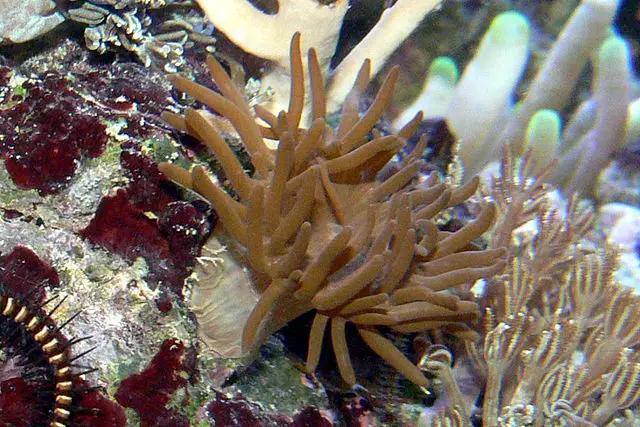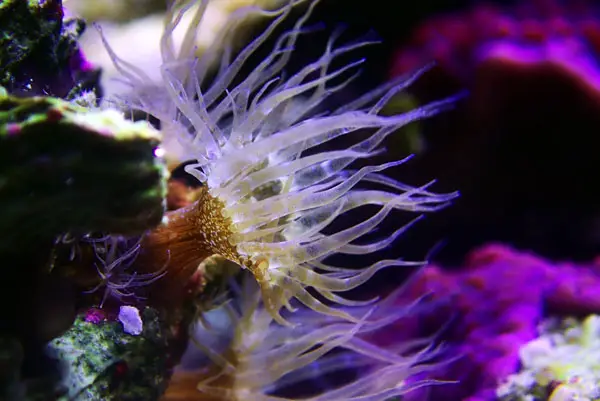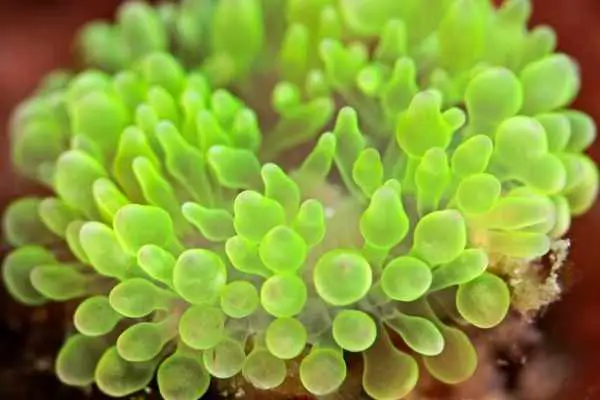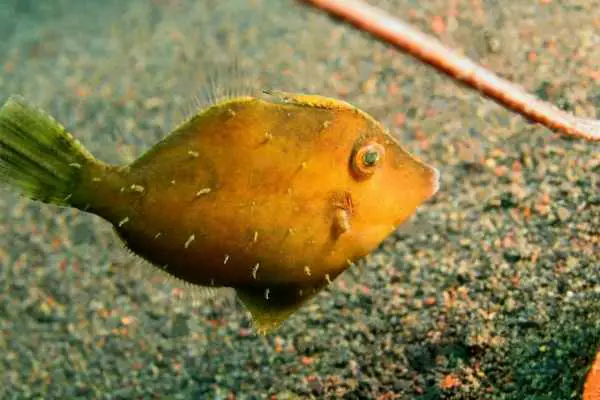Hobbyists know the look of the dreaded Aiptasia anemone. Spotting this plague of saltwater aquariums is an acquired skill (not to mention learning to route the invader). But what about the similar majano anemone? You need to look close to tell the two species apart. And, yes, it matters. Because the methods used to remove Aiptasia won’t always work on majanos. And the last thing you want is a GROWING infestation.
Table of Contents: Majano Anemone
If you don’t have a reef tank, you may consider leaving the majano anemone alone. It sounds crazy, but there are hobbyists out there who’ve made their peace with the invertebrate. A few others even CULTIVATE the beast. (Shocking, right?) But both cases require CAREFUL management. For the rest of us, it’s eradicate on sight. And that means knowing exactly what you’re dealing with. Good thing you’re in the right place for all of your anemone-busting needs.
- What are Majano Anemones?
- Recognizing Majano Anemones in Your Tank
- Preventing Majano Anemone Infestations
- Removing Majano Anemones
- For More Information

What are Majano Anemones?
Majano anemones (Anemonia majano) belong to the family Actiniidae. They’re found on rocky structures in shallow waters throughout the Indo-Pacific. It doesn’t take long for impressive colonies to swarm over any rigid substrate – especially without a predatory influence to keep them in check. (Something to keep in mind if you decide that lone anemone in your tank isn’t bothering you)
While on the small side – they rarely get more than 1.5 inches (3cm) in diameter – a majano anemone still packs a punch. Like other sea anemones, they possess nematocysts or stinging cells in their tentacles. And those nematocysts pose a threat to corals. Add on the insane replication abilities (which we’ll get to in a moment), and it’s no wonder majanos appear on the “pest” list for aquariums.
Aiptasia, Ball, or Majano?
You usually end up with a majano anemone in your tank courtesy of a live rock addition. The tiny anemone sneaks in, hidden within the crevices of the structure. However, it’s not the only hitchhiker that comes into a tank this way. And while the “kill everything with fire” mentality sounds like a plan, it doesn’t work for your aquarium’s health. You need to know whether you have majano anemones or something similar – say Aiptasia.
Aiptasia are around the same size. They also have a narrow pedal column that adheres to a rigid substrate, courtesy of the foot. The best way to tell the two species apart is to look at the tentacles. A majano will have shorter tentacles with rounded ends. In comparison, Aiptasia have slender tentacles that come to points. Also, Aiptasia don’t display color. They’re a dull beige or tan.
But that’s where another complication comes in. The ball anemone IS colorful, making it easier to confuse with the majano anemone. However, ball anemones aren’t pests. They’re also not anemones. They belong to the corallimorph group with other mushroom corals. If you want to tell the difference, look for a prominent ball at the end of the tentacle.

Plague Proportions
If majano anemones are so tricky to identify, why not leave them be? After all, they DO bring a touch of color to a display tank. (Unlike their ho-hum Aiptasia cousins) And tentacles dancing in a current always add dynamic movement to an aquarium.
Unfortunately, the majano shares one tiny (okay, not so tiny) habit with Aiptasia: insane replication capabilities. At the first sign of danger, the anemone can release HUNDREDS of spores throughout a tank. Each spore represents a new anemone, ready to settle and start a new colony. It takes NO time for that single hitchhiker to turn into a full-fledged plague.
Even an attractive plague.
And, as with any anemone species, it doesn’t take more than a TINY piece of the main animal to produce a full-fledged adult. It’s called pedal laceration. As the majano wanders around the tank (did we forget to mention their penchant for “walking?”), it leaves behind cells. Those cells then grow into new anemones. So even a happy, content majano WILL colonize your aquarium in no time.
Recognizing Majano Anemones in Your Tank
Once you spot the colorful, rounded ends of a majano anemone, you know you’re in trouble. They’ll start spreading over every hard surface they can reach. That can include your filters, pumps, and (of course) corals. If they have enough nutrients and light to thrive, they will. (And if you have a healthy tank, the invertebrates will find the resources they need)
The pedal column’s usually a green, brown, or tan color. The tentacles then come in a range of colors, with lighter tips. Again, they’re NOT unattractive. And some hobbyists combine that beauty with function. Since majano anemones gobble up nutrients, they’ll add the species to refugiums. The tentacles then act as natural filters for the aquarium in a confined location. It’s a risky maneuver, though.
If ANY piece of the anemone manages to wiggle free of the refugium, you’ll seed the tank. It requires special screening to prevent “escapes.” And you should perform routine checks of your pump intakes. But it IS an option (if you feel brave).
For the majority of the aquarium hobby, though, the sight of a majano anemone is cause for alarm. Lovely or not, you’d rather they NOT put in an appearance.

Preventing Majano Anemone Infestations
Unless you voluntarily introduced majano anemones into your aquarium, they arrived as a hitchhiker. Tiny pieces of the invertebrate hide deep in the nooks and crannies of live rock, coral, or even float free in the water. So it’s not difficult to end up with the pest in your beautiful reef tank at some point.
That’s not to say you can’t do your best to prevent the situation as much as possible.
Quarantine is your best friend. You want to observe EVERYTHING you plan to introduce to your aquarium for as long as you can. Majano anemones thrive on light. Like coral, they rely on zooxanthellae to provide their nutrients. So they WILL emerge and grow toward a light source given enough time. This will give you a chance to spot the invader and deal with it – before the anemone enters your display tank.
You also need to consider where you purchase your fish and coral from. Not every fish store practices healthy tank living. They may have tanks with majano populations. As staff scrub things, they agitate and irritate the anemones. That releases spores into the water. And then someone scoops up YOUR fish or coral purchase with the water.
If you’re not paying attention to your acclimation, you can add those spores to your tank.
While it’s always important to support small businesses and shop local, scour those tanks closely. If you feel uncertain, skip the purchase. You’ll be better off buying from an online retailer with a guarantee. (Though you still need to quarantine your fish)

Removing Majano Anemones
Who doesn’t love beautiful anemones? They sway in the current, filter extra nutrients from the system, and provide potential spots for fish and invertebrates to explore. (You know, when they’re not hazards) But majanos overstay their welcome. Once one gains a foothold, it takes over the entire tank.
Even worse, they’re a threat to your corals. Those nematocysts lash out, and over time, they’ll lead to cell death. Then the anemone will overgrow the calcium skeleton of the dead coral. Unless you fancy a tank of wall-to-wall majanos, you need to contemplate removing the pest.
But it’s easier said than done. And you need to proceed carefully. Things that work for Aiptasia don’t always work on majano anemones. It’s why identification is an essential part of the removal process. The last thing you want is to start eradicating your pest and find MORE exploded overnight.
Physical Removal
Yes, it’s tedious. And you need the precision of a surgeon. But physical removal is one of the top methods to get rid of majano anemones. You won’t need to worry about throwing off the water quality, and you shouldn’t see a resulting bloom due to spore releases.
Of course, if you’re facing a MAJOR plague, you might feel like you’re facing an impossible chore.
The nice part about majanos is they don’t grip rocks as tightly with their feet as Aiptasia. It allows you to use tweezers, scalpels, razor blades, or even a dental pick to loosen that grasp. And you won’t need to fuss about leaving tissue behind. But you still need a bit of skill to get the technique right.
- Aim your tool of choice straight through the mouth of the majano.
- Gently scrape the rock back and forth, removing ALL of the foot.
- Suction the majano away.
If a particular anemone is embedded in a tricky spot, consider taking the rock or bit of décor out of the tank. This should offer you more room to move around. (Not to mention lowering the risk of spore dispersal)
The worst part of physical removal is failing to get ALL of the majano. It’ll regrow on you. Then you have to start over. Not so bad if you only have one in your tank, but kind of terrible if you have – well, more than one.
Chemical Removal
For major majano anemone infestations, you’ll see hobbyists reach for chemical solutions. (Yes, that pun was intended) Like Aiptasia, majanos are susceptible to a bit of chemical warfare. And when you’re dead on target with your delivery, it’s an effective way of dealing with the pest.
But there are problems with this route.
First, you ARE dealing with chemicals. While calcium hydroxide (this is Kalkwasser, by the way) sounds natural, it WILL shift your water balance. And the more anemones you need to deal with, the greater the risk to your tank. The pH and alkalinity will shift if you’re not careful.
Second, you’re dealing with chemicals. (Is there an echo?) You need to protect yourself. NEVER handle the undiluted product with your bare hands. It’s a base. And while most people consider acids a problem, bases cause damage, too. You could end up with burns to your skin. Using a mask while you mix things isn’t a bad idea, either.
Sure, you could hurt yourself with the scalpel or razor for physical removal, but sharp objects usually prompt the “safety” alarm in the back of your mind. Chemicals don’t always do that.
Third, you need to remember to prepare your tank. If you leave your powerheads and pumps running while you administer the chemical treatments, you’ll defeat yourself. The water movement will blow everything around – quite possibly onto your corals. That’s a recipe for disaster. It’s extra work you don’t need to do with some of the other removal methods.
That said, you can use any of these products to eliminate majano anemones:
- Aiptaisa-X
- Joe’s Juice
- Kalkwasser
- Pickling Lime
ALWAYS read the instructions FIRST. You’ll need to prepare the product per the company’s recommendations. You should also decide how you plan to inject the chemical into the anemone. They WILL react with that spore-spitting defense if they sense a threat. So choose a method that won’t cause further problems.
To work the most effectively, chemicals need to go into the mouth of the majano anemone. It’ll seal the oral disc and prevent the release of those spores. Then the invertebrate will die. That WILL lead to a spike in nitrates, though, so try not to treat too many at once.
Majano Wand
Now, if money’s no expense when dealing with pests, the Majano Wand is your go-to. It’s also your chance to play with electricity and water. (Safely! You’ll want to read the instructions to avoid a trip to the hospital)
The Wand “zaps” majano anemones – literally. The electricity breaks the hydrogen bonds in the water cells inside the pest. It results in instant disintegration. (Feel free to insert your best Emperor Palpatine impression as you do so) Of course, if the majano feels you approaching, they might send out some spores before they get “jolted.” But that means you can deploy the Wand again. (Maybe a win-win?)
This YouTube video walks you through how to use a Majano Wand:
Now, obviously, there are some downsides involved. The cost, for one. And you still need to take it easy. The battery SHOULD give out before you go too crazy frying anemones. But you should limit how many you “send to the depths” so you don’t elevate that nitrate level.
Moderation may not be a tenant of the Dark Side, but it definitely applies here.
“Housekeeping”
Everyone has their favorite Aiptasia-eradication species. And while you can TRY using them to eliminate an infestation of majano anemone, it’s not a guarantee they’ll work. The two species aren’t the same, and those fish and invertebrates can tell the difference. Presented with a tank full of majanos, they may turn up their nose.
This means your peppermint shrimp, Berghia nudibranchs, copperband butterflyfish, and foxface rabbitfish will look fantastic. But they won’t help. And if you didn’t already have them in your tank, you’ll add them for no reason.
The one exception to the group is the bristle tail filefish. They’ll happily devour majanos all day long. And as you can see in this YouTube video, they’re HIGHLY effective at eradicating the pest:
Unfortunately, filefish aren’t ideal for reef tanks. They go after zoanthids, mushroom corals, shrimp, crabs, and even clams. So when they’ve eliminated your majano problem, you’ll find yourself with a new issue. That means thinking carefully about whether they’re the solution you want. You may want to coordinate with a fellow hobbyist (or the fish store) before you add one to your tank.
For More Information
Who knew there was something more annoying than Aiptasia? Majano anemones look similar. And they’re equally frustrating to eliminate from a tank. Even worse, methods that work on their cousins may not yield the same results. It’s an irritating situation hobbyists find themselves facing all the time. But that’s why you ducked in for these last few snippets of information.
Such as this YouTube video explaining how to beat majano anemones in saltwater aquariums:
In addition to the filefish, you can give these angelfish a try at “housekeeping” species (It’s not a guarantee, but they have a penchant for munching on anemones):
Conclusion
Can you believe some hobbyists maintain majano anemones for FUN? Well, not fun, perhaps. Functional. In refugiums, the invertebrate carries out a filtration role. Those tentacles take down the nutrient load. And, in seclusion, the pest can’t turn into – well, a pest. If you’re willing to take the necessary precautions against an escape, it’s one way to manage the health of your reef tank.
But if even a tiny piece of the anemone escapes, you need to have a game plan for removal. It takes no time for the anemone to grow out of control. And no one wants to see their tank turn into a display of majanos. Whether you’re prepared to import a filefish or want to save up for the Wand, have your method ready to go.
References
- Nilsen, A.J. and Fossa, S.A. 2003. Reef Secrets: Starting Right, Selecting Fishes and Invertebrates: Advanced Biotope Techniques.
- Shimek, R.L. 2005. Guide to Marine Invertebrates: 500+ Essential-to-Know Aquarium Species.


Leave a Reply